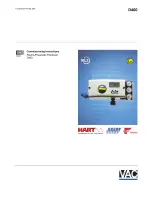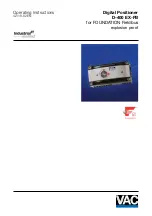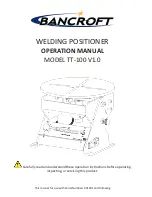
Instruction Manual
PPR Series
Pneumatic-Pneumatic Positioner
1. Read all safety instructions in this manual carefully before using this product. All work
should be done by staff with the necessary training and experience.
2. An air filter regulator should be installed before the positioner.
1. Part Number System
PPR
―
Feedback
Shaft
Pressure
Gauge
(SUP.
OUT)
Pilot
Valve
Orifice
Position
Feedback
Connection
Threads
Dome
Indicator
High
Temp
Mounting
Bracket
Description
Code
Description
Code
Feedback Shat:
Pressure
Gauge:
Pilot Valve
Orifice:
Position
Feedback:
N: NAMUR shaft (direct mounting)
A: Fork lever M6x40L
B: Fork lever other size on request
1: 6 bar (90 psi)
2: 10 bar (150 psi)
S: Standard
(actuator volume over 180
㎤
)
M: Small orifice (
Φ
1.0 or
Φ
0.7)
(actuator volume 90~180
㎤
)
N: None (standard)
O: Position transmitter
(4~20mA output signal)
L: 2 x SPDT limit switches
M: O+L
Connection
Threads:
(pneumatic)
Dome Indicator:
High
Temperature:
Mounting
Bracket:
3: Rc 1/4
4: NPT 1/4
N: Flat indicator (standard)
D: Dome indicator
T: 70
℃
(standard)
H: 120
℃
(without position feedback option)
85
℃
(with position feedback option)
N: None
R: Multi-size NAMUR bracket
for DIN VDI/VDE 3845
F: DHCT bracket 80x30
for fork lever type
E: Multi-size NAMUR bracket
for fork lever type
2. Specifications
PPR
Rotary Type (Cam Feedback)
Single Double
Input Signal
0.2~1.0 kgf/
㎠
(3 ~ 15psi) (Note 1)
Air Supply
Max. 7.0bar (100psi) free of oil, water, and moisture
Standard Stroke
60 ~ 100 ° (Note. 2)
Pneumatic Connections
Rc 1/4 or NPT 1/4
Ambient Temperature
-20 ~ +70
℃
Pressure Gauge
Stainless Steel
Output Characteristics
Linear
Linearity
Within ± 1.0 % F.S
Within ± 1.5 % F.S
Sensitivity
Within ± 0.2 % F.S
Within ± 0.5 % F.S
Hysteresis
Within ± 1.0 % F.S
Repeatability
Within ± 0.5 % F.S
Air Consumption
5 LPM (Sup. 1.4kgf/
㎠
)
Flow Capacity
80 LPM (Sup. 1.4kgf/
㎠
)
Material Aluminum
Die-cast
Body
Weight 2.5
kg
Note: 1) It is adjustable to set 1/2 spilt range for 3-9psi input signal or 9-15psi input signal.
2
) Stroke can be adjusted to 0~60° or 0~100°
3. Mounting and Selecting RA (reverse acting) or DA (direct
acting)
CAUTION: Keep assembly tightly closed during operation.
A. Mounting with NAMUR type
The PPR positioner basically has the NAMUR shaft which can be directly
mounted to the top pinion (VDI/VDE 3845) of the pneumatic rotary
actuator..
①
Mount the NAMUR multi-size bracket to the pneumatic rotary actuator
with the enclosed bolts (4 x M5) as shown to the right.
②
Mount the positioner to the bracket and insert the positioner feedback
shaft into the actuator top pinion (output shaft) as shown to the right.
③
Fix the positioner to the bracket with the enclosed bolts (4 x M6).
A multi-size bracket is assembled for 80x30x20 as a standard
factory setting. But the user can re-assemble it for 80x30x30, 130x30x20, and 130x30x30 according to
requirements as shown below.
B. Mounting with fork lever type
Mount the PPR positioner to the actuator with DHCT
bracket (80x30) as shown to the right. Be sure that the
feedback lever shaft “A” is placed in the orifice for the fork
lever “B” and they are in alignment with a rotary actuator
output shaft.
C. Cam and Indicator Adjustment
WARNING: When adjusting or replacing cams, be sure to shut off air supply to the PPR
positioner. Otherwise, the PPR positioner might react suddenly and cause
damage or injury.
RA (reverse acting) is a standard factory setting.
①
Loosen a flange nut on a cam and reverse a cam for DA setting. Match the part of the cam with "0" marked on it with the
center of bearing as shown below. The span adjusting arm unit should now be aligned.
②
Tighten the flange nut of the cam after setting the cam.
③
After cam installation, proceed to adjust zero and span. Once this is complete, secure the indicator with the bolt (M6) to
the feedback shaft according to the actuator type (RA or DA) as shown below. The position for the indicator should be
arranged in the scale (0-90 degrees) shown on the cover.
[RA] [DA]
4. Air Connections
5. Internal View
Never move the seat adjuster. It was already set at the factory precisely.








